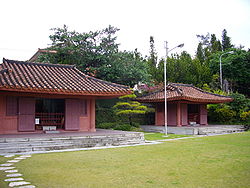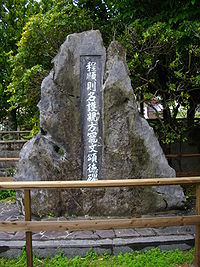
Shiseibyo
Encyclopedia


Temple of Confucius
A Temple of Confucius or Confucian temple is a temple devoted to the memory of Confucius and the sages and philosophers of Confucianism.- History :...
in the Wakasa district of Naha, Okinawa
Naha, Okinawa
is the capital city of the Japanese prefecture of Okinawa.Naha is a coastal city located on the East China Sea coast of the southern part of Okinawa Island, the largest of the Ryukyu Islands...
. It served for centuries as a major center of Chinese learning for the Ryūkyū Kingdom
Ryukyu Kingdom
The Ryūkyū Kingdom was an independent kingdom which ruled most of the Ryukyu Islands from the 15th century to the 19th century. The Kings of Ryūkyū unified Okinawa Island and extended the kingdom to the Amami Islands in modern-day Kagoshima Prefecture, and the Sakishima Islands near Taiwan...
, and contains within its precincts the Meirindō, first public school in Okinawa.
History
The current temple was built in 1975, as a rebuilding of an older temple located a short distance away, near what is now a major highway, Japan National Route 58.The original temple was built in 1671-75 as a gift to the Ryūkyū Kingdom from the Chinese Emperor
Emperor of China
The Emperor of China refers to any sovereign of Imperial China reigning between the founding of Qin Dynasty of China, united by the King of Qin in 221 BCE, and the fall of Yuan Shikai's Empire of China in 1916. When referred to as the Son of Heaven , a title that predates the Qin unification, the...
Kangxi. It served as the primary Confucian temple of the kingdom, and would soon become a center of learning within Kumemura
Kumemura
Kumemura , located on Okinawa, in the port city of Naha and near the royal capital of Shuri, was a community of scholars, bureaucrats, and diplomats, and a center of culture and learning during the time of the Ryūkyū Kingdom...
, the community of scholars and bureaucrats which was the center of Chinese culture and learning in the kingdom. In 1718, local official Tei Junsoku
Tei Junsoku
' was a Confucian scholar and government official of the Ryūkyū Kingdom. He has been described as being "in an unofficial sense... the 'minister of education'", and is particularly famous for his contributions to scholarship and education in Okinawa and Japan...
, magistrate of Kumemura, and something of an unofficial minister of education, established the Meirindō, the first formal educational institute in the kingdom, as a center of learning for the Kumemura community of scholar-bureaucrats.
Following the abolition of the kingdom and annexation of Okinawa by Japan in 1879, the Kumemura community, along with the Meirindō school and the temple as a whole, fell into decline. The Meirindō became a municipal office and public school under the national education system
Education in Japan
In Japan, education is compulsory at the elementary and lower secondary levels. Approximately 98% of all students progress to the upper secondary level, which is voluntary . Most students attend public schools through the lower secondary level, but private education is popular at the upper...
established under the Meiji government
Government of Meiji Japan
The Government of Meiji Japan was the government which was formed by politicians of the Satsuma Domain, Chōshū Domain and Tenno. The Meiji government was the early government of the Empire of Japan....
. Historian George Kerr cites a July 1910 newspaper advertisement as the last evidence of public interest in annual ceremonial visits to the temple by those who had lived in the time of the Ryūkyū Kingdom.
The temple was destroyed in the 1945 battle of Okinawa
Battle of Okinawa
The Battle of Okinawa, codenamed Operation Iceberg, was fought on the Ryukyu Islands of Okinawa and was the largest amphibious assault in the Pacific War of World War II. The 82-day-long battle lasted from early April until mid-June 1945...
and rebuilt in 1975 on the premises of the Tensonbyō, a smaller Confucian temple in the Wakasa area also destroyed in the battle.
Buildings and monuments
The temple grounds are small, covering roughly one or two acres. The central devotion hall, called Taiseiden (大成殿), is a shrine not only to ConfuciusConfucius
Confucius , literally "Master Kong", was a Chinese thinker and social philosopher of the Spring and Autumn Period....
, but also to Chinese philosophers Zengzi
Zengzi
Zengzi , born Zeng Shen , courtesy name Ziyu , was a Chinese philosopher and student of Confucius.He is credited with having authored a large portion of the Great Learning, including its foreword. Zengzi's disciples are believed to have been among the most important compilers of the Analects of...
, Zisi, Anzi
Anzi
Anzi is a town and comune in the province of Potenza, in the Southern Italian region of Basilicata. It is bounded by the comuni of Abriola, Brindisi Montagna, Calvello, Castelmezzano, Laurenzana, Pignola, Potenza, Trivigno....
, and Mencius
Mencius
Mencius was a Chinese philosopher who was arguably the most famous Confucian after Confucius himself.-Life:Mencius, also known by his birth name Meng Ke or Ko, was born in the State of Zou, now forming the territory of the county-level city of Zoucheng , Shandong province, only thirty kilometres ...
.
A smaller building to the left of the entrance, called the Tenson-byō (天尊廟), is devoted to those who fought to defend the country, and to Guan Yu
Guan Yu
Guan Yu was a general serving under the warlord Liu Bei during the late Eastern Han Dynasty of China. He played a significant role in the civil war that led to the collapse of the Han Dynasty and the establishment of the state of Shu Han during the Three Kingdoms period, of which Liu Bei was the...
and the Dragon King
Dragon King
The four Dragon Kings are, in Chinese mythology, the divine rulers of the four seas . Although Dragon Kings appear in their true forms as dragons, they have the ability to shapeshift into human form...
, Taoist
Taoism
Taoism refers to a philosophical or religious tradition in which the basic concept is to establish harmony with the Tao , which is the mechanism of everything that exists...
deities and figures in Chinese folklore and mythology. The Tensonbyō was located on this site prior to 1975, when the old Kumemura Confucian temple, destroyed in World War II, was rebuilt here as the Shiseidō, incorporating the Tensonbyō into the new facility. The Tenpigū (天妃宮) next to it is devoted to Tenpi, also called Matsu or Mazu, the Taoist goddess of the sea, of sailors, navigators, and fishermen.
The Meirindō (明倫堂) lies to the right of the entrance, next to the temple offices, and currently serves as the meeting place for the local , and holds an archive of roughly 10,000 volumes ranging from historical documents related to the locality and to foreign trade, to schoolbooks.
Three memorial stele
Stele
A stele , also stela , is a stone or wooden slab, generally taller than it is wide, erected for funerals or commemorative purposes, most usually decorated with the names and titles of the deceased or living — inscribed, carved in relief , or painted onto the slab...
s are located within the temple grounds: one to the Chūzan
Chuzan
Chūzan was one of three kingdoms which controlled Okinawa in the 14th century. Okinawa, previously controlled by a number of local chieftains or lords, loosely bound by a paramount chieftain or king of the entire island, split into these three more solidly defined kingdoms within a few years after...
Confucian temple originally established in the 17th century as a gift from the Kangxi Emperor; one to Sai On
Sai On
', also known as ' was a scholar-bureaucrat official of the Ryūkyū Kingdom, serving as regent, instructor, and advisor to King Shō Kei...
, historian, government official, reformed, and royal regent at the time the temple was constructed; and one to Tei Junsoku, magistrate of Kumemura and educational force who established the Meirindō as a center of learning.

